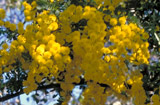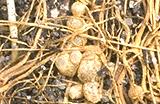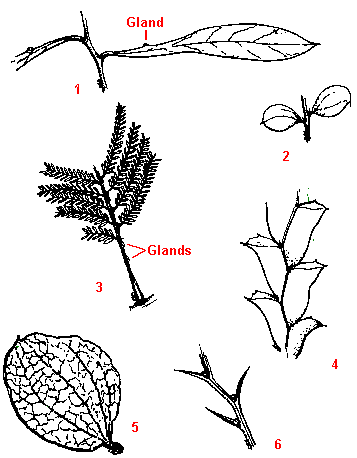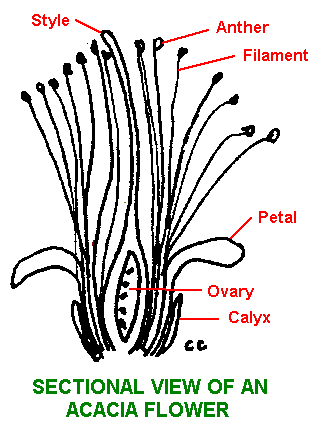|
[Front Page] [Features] [Departments] [SGAP Home Page] [Subscribe]

A Simple Botany of Wattles
Calder Chaffey
Introduction
Editor's Note: Even a simple botany will produce terminology which is unfamiliar to some readers. The Glossary of Botanical Terms is an excellent reference which includes hundreds of definitions.
The intention in this paper is to describe the characteristics of the genus Acacia, the Wattles, in a simple way which may be easily followed without having to be familiar with technical terms. Whilst doing this the text is expanded to further describe and explain some interesting structures and functions of acacias.
The system of modern classification and naming of all living organisms was devised by Linnaeus. The system is so arranged that every living thing is known by two names, the genus and species and no two dissimilar organisms may have the same name. It places together, in the largest groups, organisms with the most fundamental similarities which are thought to be of genetic origin. These groups are divided and subdivided into smaller groups of more closely related organisms. Plants, like animals, after several; subdivisions, are collected into families. All members of each family have similarities of flower structure and are thought to have descended from a common ancestor. Each family is further divided into a number of genera and these further divided into species which have more similar characteristics of genetic origin. Ultimately each group of plants which appear to have the same structures are given the same specific name.
It is sometimes very difficult to determine the genetic relationships of some plants. For instance, such things as parallel evolution may deceive one into grouping together two plants which are not closely related, in spite of some common characteristics. These similarities have evolved by the respective species developing similarities although they come from unrelated families. These difficulties have caused some botanists to classify some plants differently from other botanists. Each thinks their system is better able to explain the genetic groupings more accurately. This explains why occasionally a plant may appear in a family different from that usually accepted.
Wattles are one such group where there are differences of opinion as to the genetic relationships. The classification in this paper is based upon that devised by Dahlgren. He places wattles in the Family Fabaceae (FAB A SEE) which used to be called Leguminoceae (LE GUME IN O SEE). This is a large family and Dahlgren further divides it into three subfamilies.
- Caesalpinioideae; Cassia and Bauhinia, etc...
- Faboideae (old name Papillonoideae); the peas.
- Mimosoideae; the wattles and mimosas, ie. Acacia and Mimosa.
| The Wattles |
| Family | Fabaceae |
| Subfamily | Mimosoideae |
| Genus | Acacia |
|
Many botanists consider that Acacia should be divided into several smaller genera but there is no consensus on the number or composition of the separate genera.
Description
Growth Habit
Acacias are mostly trees or shrubs, rarely herbs.
 |
The "Mudgee Wattle", Acacia spectabilis is a widely cultivated small tree which produces a spectacular display in late winter. Select the thumbnail image or plant name for a higher resolution image (45k).
|
Root System
Roots of many acacias grow very deep. During the digging of the Suez Canal some roots were found at 30 m. Feeder roots, which absorb water and minerals, do not go so deep, but are usually at depths up to 15 cm beneath the surface. They spread out around the tree, usually somewhat wider in diameter that the canopy. Other acacias form stolons which are thin, wiry roots growing just beneath the surface of the ground. These may shoot to form new plants at intervals.
Nitrogen Conversions
Nitrogen is an essential element for plant growth, being used in the formation of protein. Nitrogen is abundant in air (four-fifths of the atmosphere) but this is unusable by plants. So that it may be used it has to be in the form of nitrate, nitrite or ammonia. Only certain bacteria or blue-green algae can make this conversion. All other life on earth depends on these. These are called procaryotes and achieve this chemical change by the use of an enzyme called nitrogenase. An enzyme is a protein produced in a cell and aids a specific chemical reaction to take place. Nitrogenase is a complex chemical containing molybdenum, iron, sulphide radicals and ademosine triphosphate (ATP).
Blue-green algae also require cobalt as a micronutrient, i.e. a trace element. Plants may contain nitrifying bacteria in their tissues from which they get usable nitrogenous chemicals or absorb the chemicals discharged into the soil from other decomposing dead plants.
Acacias usually obtain usable nitrogen in both ways. Most have root modules containing bacteria (Rhizobium species), capable of taking up atmospheric nitrogen and converting it into a form usable by the plant. Root nodules, an anatomical modification of the plant root, caused by these specific bacteria, are the result of a symbiotic association between the plant and bacteria. The bacteria take in atmospheric nitrogen and by use of an enzyme make it available to the host plant. The host makes sugars available to the bacteria in return. Sugars are high energy carbon compounds used in cell growth and function.

Rhizobium spp. are ubiquitous in the soil and attack the acacias through root hairs which are caused to bend. The bacteria attach to the hair on the concave side. Growth is arrested at the root tip and transferred to the attachment point. Invasion of the bacteria is not direct but through a tube-like structure (infection thread) which penetrates the root hair and is formed of hair tissue. This grows to the base of the hair and becomes meristematic, ie. causes a zone of frequent cell division in an orderly manner but not so well defined as in a growing bud.
 |
The root nodules on the roots of an Acacia can often be seen by removing a small plant from its container. Select the thumbnail image or highlighted phrase for a higher resolution image (58k).
|
The dividing cells grow in all directions and form a spherical nodule in which a vascular system develops. The infection threads form vesicles in the cells of the nodule which become filled with bacterial cells. The invaded cells only live for a few days, then degenerate and are replaced by new cells from the meristem. Because of this symbiosis, resulting in a supply of usable nitrogen to the wattle, many species may grow in relatively poor soils and are often the first successful colonists. In the tropics these colonisers grow so rapidly that they choke out other plants.
Bark
True bark is not formed in acacias, The cortex and epidermis, ie. the tissues of the outer covering layers of the trunk, expand continuously and function as long as the tree lives. The trunk often remains green although it may become brown and flaky in older and larger trees. These tissues are rich in tannin-sacs from which tannin was extracted in many species and used to tan leather and old time cord fishing nets.
Pith and medullary rays contain gum passages from which gum-arabic is made (A.senegal) once used as a simple water soluble glue such as on envelopes.
Leaves
Leaves are alternate, often compound and divided twice (bipinnate). They do not persist on the plants into adulthood although they may reappear as the plant matures. Usually they are reduced to leaf stalks which have lost the leaf blades (phyllodes) or rarely they may be completely absent. In some species the leaf is modified into a thorn or a thorn may sprout from a node where a lea stalk would otherwise develop.
 
Phyllodes and Leaves
- 1 and 2: Phyllodes of different shapes
- 3: Fern-like (bipinnate foliage)
- 4: Winged stems, the only foliage on some species
- 5; A phyllode showing net-veins
- 6: Phyllodes are reduced to spines on some species
Phyllodes may have obscure veins, one prominent longitudinal vein, or two or more prominent longitudinal veins. These are probably the result of evolution under xeric conditions ie. in a habitat, very dry to a state of dehydration. The loss of leaf-blades helped combat water loss. With improvement of conditions the leaf stalks expanded into flattened leaf-like phyllodes exposing more chlorophyll to sunlight and acting like leaf-blades.
Leaves and phyllodes are joined to the branchlets through a swelling called a pulvinis. This organ is associated with the movement of the phyllode or leaf in response to light, water conservation or wind.
A gland is usually present on the upper margin of the phyllode near the stem.
Compound leaves have a petiolar gland near the main stem (primary rachis) and often jugary glands between each pair of stem divisions (secondary rachises) or interjugary glands between two pairs. When the divisions of a compound leaf are paired, ie. opposite, they are said to be jugate.
Glands secrete polysaccharides or sweet compounds, produced by nectaries within. The sweet substances attract ants which protect the trees from other insects. A few species of Acacia have hollow thorns in which ants live and often form colonies. It has been recorded that the ants, of many of these trees, ring-bark branches of close by trees which tend to grow into or crowd their Acacia homes. Careful experiment has shown that on removing the ants, those trees cease to thrive. This could be the result of predators moving in or the effects of crowding from surrounding trees. Acacias not normally inhabited regularly by ants usually have bitter-tasting chemicals in their tissues which probably have the same effect of deterring predators.
Stipules (a pair of wings, one on either side, developed from the leaf base) are usually present. They are usually small and wither away soon after leaf development (caducous), but sometimes they are prominent and spine-like.
Flowers
Floral shoots are racemes, spikes or single heads. The individual flowers are usually small and clustered. Bracteoles are small or absent.
Flower heads come from the upper angle between the leaf or phyllode and the branchlet i.e. they are axillary. There are four types of flower heads:
- Cylindrical, like a pipe cleaner.
- Pair of single globose (spherical) flower heads on separate stems.
- Pair of single globose flower heads, each on a stem, each coming from a single common axillary shoot.
- Five globose flower heads, each on a single stem coming from an extended axillary stem.
 
Flowers
- A ball flower head enlarged to show individual flowers
- One single flower enlarged 15 times
- Ball flower heads in racemes (spikes of flower)
- Ball flower heads, solitary, from a phyllode axil
- Rod flower head and a phyllode with 3 veins or nerves
Flowers are actinomorphic, ie. the whorls of flower parts sepals, petals and stamens are radially symmetrical so that the flower can be bisected symmetrically in several planes. The calyx and corolla valvate, ie. they are fused below and the edges above may touch but do not overlap.
Flowers are 5-merous, ie. there are 5 parts in each floral whorl, eg. whorl of petals, calyx, sepals etc. But many are 4-merous.
 
Stamens are the most conspicuous part of the flower. Usually they are very numerous (more than 10). They vary greatly in number, their number and occasional adhesion provide distinctive tribal characteristics and are important in identification. Wattles are recognised by the globes or pipecleaner- shaped clusters of yellow or golden stamens but it is not generally known that the flowers have tiny petals and few people have looked closely enough to see them. Separate a single flower and examine around the base with a 10x lens. The petals can then be clearly seen.
Filaments are free, long and slender and crowned by small bilocular anthers which open by longitudinal slits to discharge pollen contained within. Occasionally anther-chambers are divided by several transverse
septa.
The stile and stigma are terminal.
Ovary is superior, the floral whorls being inserted below the ovary. The carpel or female unit of the flower is solitary, the placenta marginal and the ovules usually numerous attached to the upper suture of the fruit.
Pollen grains are often united into small packets.
Fruits and Seeds
Fruit, derived from one carpel, is a pod or bean-like structure (a legume) containing many seeds attached near the upper suture. It is dehiscent, ie. liberates seeds, by splitting along both sutures.
Seeds have a leathery testa or coating. The endosperm, or nutritive material within the seed, is generally absent or sparsely developed. The embryo has two large flat cotyledons with a usually superior or ventrally placed radical, the organ which gives rise to the primary root system.
Other Features
Timber varies between the species but some are useful for building, furniture material and specialised use. For example A.melanoxylon is a fine hard decorative timber used in furniture (blackwood, sally wattle). Use is now being made of the seeds of some species in preparing 'bush tucker'.
Aborigines used many parts of acacias for food. Roots of young trees were roasted. Gum was collected and chewed or used as an adhesive. Notches were often cut in the trunk and branches to cause the exudation of gum, and sap. Sap was used to make a sweet drink. It is thought that tannin was used to stupefy fish, seed for food and gum. Strips of young bark were used as a binding material and making bags, fishing nets, sandals and pubic tassels. The wood was used for spear shafts, axe handles, digging sticks, boomerangs, fire sticks and fire wood. Acacia ash was mixed with native tobacco. From the wood witjuty grubs and honey ants were extracted.
Acacias are very useful in horticulture for landscaping, garden and specimen plants.
Calder Chaffey is a long time member of the Society for Growing Australian Plants. He has a particular interest in the local flora of the New South Wales North Coast (where he lives), ferns and the botany of the Australian flora. This article is reprinted from the newsletter of the Far North Coast Group of SGAP, July and August 1997 issues.
Diagrams of phyllodes and flowers are by Marion Symmons and are taken from the March 1988 issue of the Society's journal "Australian Plants".

[Front Page] [Features] [Departments] [SGAP Home Page] [Subscribe]
Australian Plants online - December 1997
The Society for Growing Australian Plants
|